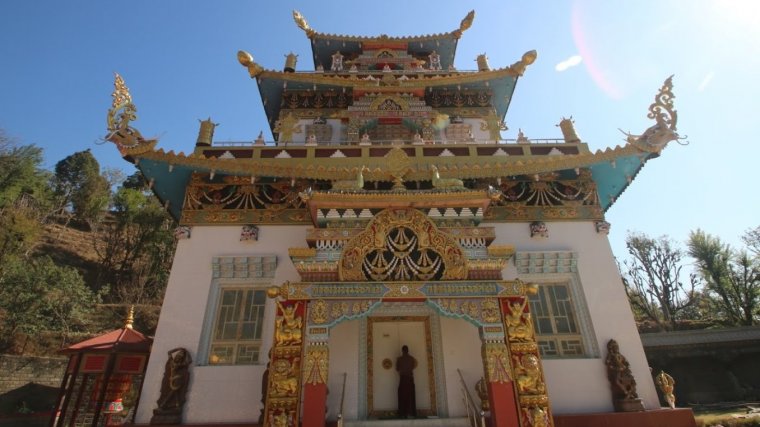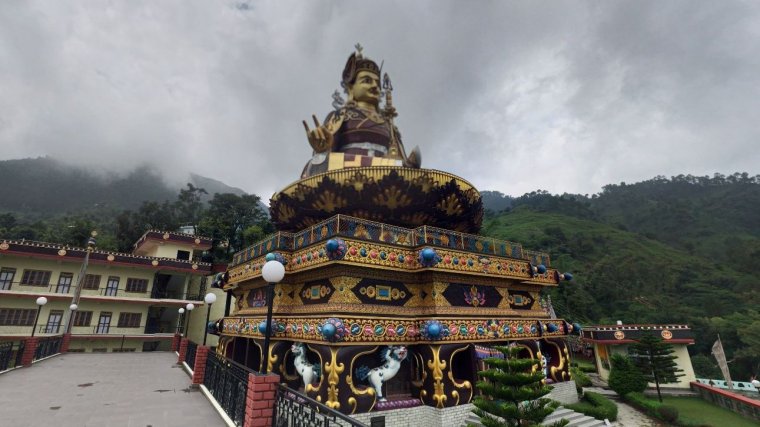| Published in Attractions / Temples, Ashrams, Monasteries |
Rewalsar Monastery, Himachal Pradesh. India
Nyingma Tradition, 8th century.
Situated at an altitude of 1360m, Rewalsar or Tso Pema in Tibetan is a small town and a pilgrimage place in Mandi district, Himachal Pradesh. The local name for Rewalsar is Tri Sangam (Three Communities). Rewalsar is revered by Buddhists, Hindus, and Sikhs.1

Tso Pema Gompa. Photo: Arimdan Das
Location
History
Buddhist tradition holds that Padmasambhava was burned at Rewalsar as punishment by king Arashadhar of Mandi, who was angered hearing rumors that Padmasambhava took his daughter, Mandarava, as a consort. When the pyre was extinguished, a lake appeared in its place with Padmasambhava seated in the middle on a lotus blossom.
The king, repenting his actions, married his daughter to Padmasambhava. It was from Tso Pema that Padmasambhava went to Tibet to reveal Vajrayana Buddhism.
The Tshechu 2 fair was held in Rewalsar in 2004 to commemorate the birthday of Padmasambhava.
The fair was inaugurated by the 14th Dalai Lama and was attended by the 17th Karmapa Ogyen Trinley Dorje along with 50,000 other Buddhist pilgrims. The fair was held after a gap of 12 years.
Features
A 37.5-meter large statue of Padmasambhava was consecrated, blessed, and inaugurated by the 14th Dalai Lama of Tibet on 1st April 2012. The building project led by Wangdor Rinpoche took nearly 10 years to complete.
It was constructed almost entirely by hand by tradespeople from the Rewalsar area as well as master artists from Nepal and Bhutan.
Monastery murals show important Nyingma masters, including Padmasambhava’s twenty-five disciples, who promoted Buddhism to Tibet by going to India, learning Sanskrit, practicing until they achieved high levels of spiritual realization, then spreading what they learned by teaching others and writing and concealing treasure-texts to be found by masters in the future.

Padmasambhava. Photo: Nirpeksh Thapa
Travel and Visiting
Rewalsar is about 24 km from Mandi town. Bhuntar Airport is the nearest one, 57 km from Mandi district.
The Nyingma Gompa has a guest house and a small shop selling blessed protection strings, flags, kataks (traditional ceremonial scarfs), and juniper incense.
Visitors usually take a kora (circumambulate) around the lake, visit Mandarava’s Cave and Padmasambhava’s Cave.
Sources
• https://en.wikipedia.org/wiki/Rewalsar,_India
• https://wikitravel.org/en/Rewalsar
• https://thelandofwanderlust.com/where-four-monasteries-and-a-sacred-lake-dwell-rewalsar-himachal-pradesh/
• http://www.indiamapped.com/monastries-in-india/himachal-pradesh-rewalsar-monastery/
• https://www.jstor.org/
Footnotes
1. At Rewalsar there are:
• Four Tibetan Buddhist monasteries: Rewalsar Nyingma Gompa, Drikung Kagyu, Zigar Drukpa Kagyu and Zangdokpalri Nyingma Monastery (popularly known as “The Lava Monastery” );
• Three Hindu temples, dedicated to the ancient Hindu sage Lomas, to Krishna and to Shiva;
• A Gurdwara (a place of assembly and worship for Sikhs, meaning "door to the guru") which was built in 1930 by Raja Joginder Sen of Mandi. It commemorates Guru Gobind Singh's visit, when he sought to evolve a common strategy with the hill rulers against the Mughal emperor Aurangzeb.
2. Tshechu (literally "day ten") are annual religious festivals held on the tenth day of a month of the lunar Tibetan calendar. The focal point of the tshechus festivals are Cham dances. These costumed, masked dances typically are moral vignettes, or based on incidents from the life of Padmasambhava and other saints.
Typically, monks perform unmasked in certain group dances, including the Black Hat dance, while laymen perform masked, in largely different plays.
YOU MAY ALSO LIKE






 If you own or manage a travel-related business such as a hotel, a bed-and-breakfast, a restaurant, a pub or a cafeteria, you can create a web page for your business for free on Titi Tudorancea Travel Info. » |